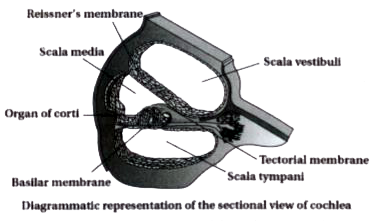Give information of various parts of human car and its function.
Text Solution
The ears perform two sensory functions, hearing and maintenance of body balance. Hence it is also called Phonoreceptor.
Anatomically, the ear can be divided into three main regions :
(a) Outer ear (b) Middle ear (c) Inner ear

(a) Outer/External ear : Consists of the pinna and external auditory canal.
Ear pinna is round, some what funnel shaped structural. Its outer rigid part is called helix and lower soft part is known as lobules. The pinna collects the vibrations in the air which produce sound.
Auditory canal is .s. shaped type, extends up to the tympanic membrane.
There are very fine hairs and wax secreting glands in the upper side of auditory canal. It prevents entry of dust particles in the ear wax glands and are also called Ceruminous glands. It secretes brown coloured fatty substance also known as Earwax. It protects and lubricate inner mining of the auditory canal.
(b) Middle ear : Tympanum is a thin, double layered epithelial partition between the external auditory canal and the middle ear.
It is made up of fibrous connection tissue, on its outer side epithelial layer and inner side muscular layer is seen.
Inner wall of tympanum is having two aperture, upper is Round Window and lower one is Oval Window. Both are surrounded by membrane.
Ear ossicles : The middle ear contains three ossicles - Malleus, Incus and Stapes attached to one another in a chain like fashion.
The malleus is attached to the tympanic membrane and stapes is attached to the oval window of the Cochlea.
The ear ossicles increase the efficiency of sound waves to the inner ear.
An Eustachian tube connects middle ear cavity with the pharynx. The Eustachian tube helps in equalising the pressure on either sides of the ear drum.
 (c ) Inner ear : The fluid filled inner ear called labyrinth consists of two parts, the bony and the membranous labyrinths.
(c ) Inner ear : The fluid filled inner ear called labyrinth consists of two parts, the bony and the membranous labyrinths.
The bony labyrinth is a series of channels. Inside these channels lies the membranous labyrinth, which is surrounded by a fluid called perilymph.
The membranous labyrinth is filled with a fluid called endolymph.
The coiled portion of the labyrinth is called cochlea.
The membranes constituting cochlea, the reissner.s membrane and basilar membrane divide the surrounding perilymph filled bony labyrinth into an upper Scala Vestibuli and a lower scala tympani
The space within cochlea called Scala media is filled with endolymph. At the base of the cochlea, the scala vestibuli ends at the oval window, while the scala tympani terminates at the round window which opens to the middle ear.
The organ of corti is a structure located on the Basilar membrane which contains hair cells that act as auditory receptors.
The hair cells are present in rows in the inner side of the organ of Corti.
The basal end of the hair cell is in close contact with the afferent nerve fibres. A large number of processes called stereo cilia are projected from the apical part of each hair cell.
Above the rows of the hair cells is a thin elastic membrane called tectorial membrane.
(ii) The inner ear also contains a complex system called vestibular apparatus located above the cochlea.
The vestibular apparatus is composed of three semi-circular canals and the otolith organ consisting of the saccule and utricle.
Each semi-circular canal lies in a different plane at right angles to each other. The membranous canals are suspended in the perilymph of the bony canals. The base of canals is swollen and is called ampulla which contains a projecting ridge called crista ampullaris which has hair cells.
The saccule and utricle contain a projecting ridge called macula. The crista and macula are the specific receptors of the vestibular apparatus responsible for maintenance of balance of the body and posture.
|
Topper's Solved these Questions
- NEURAL CONTROL AND COORDINATIONBOOK - KUMAR PRAKASHANCHAPTER - NEURAL CONTROL AND COORDINATIONEXERCISE - SECTION - B (DIFFERENCE/SCIENTIFIC REASONS)
11 Videos
- NEURAL CONTROL AND COORDINATIONBOOK - KUMAR PRAKASHANCHAPTER - NEURAL CONTROL AND COORDINATIONEXERCISE - SECTION - C (DEFINITION/EXPLANATION - TERMS/IMPORTANCE)
21 Videos
- MORPHOLOGY OF FLOWERING PLANTSBOOK - KUMAR PRAKASHANCHAPTER - MORPHOLOGY OF FLOWERING PLANTSEXERCISE - questions from module -(Important MCQ for NEET)
4 Videos
- PHOTOSYNTHESIS IN HIGHER PLANTSBOOK - KUMAR PRAKASHANCHAPTER - PHOTOSYNTHESIS IN HIGHER PLANTSEXERCISE - FILL IN BLANKS
10 Videos
Similar Questions
Give various parts of an enzyme.
View SolutionGive an account of various parts of alimentary canal of man.
View SolutionWrite down the functions of the various parts of the midbrain and hindbrain.
View SolutionDescribe the functions of various parts of brain.
View SolutionGive the role of the various parts of the forbrain.
View SolutionMatch the parts of the human eye with its function .

View SolutionExplain the functions of various parts of the eye.
View SolutionName the various parts of the large intestine of human.
View SolutionName the various parts of the large intestine of human.
View SolutionDescribe various lobes of cerebrum of human brain and their functions.
View Solution
